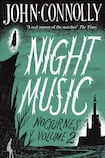
Despite its eerie cover and promises to terrify, John Connolly's Night Music, a collection of supernatural fiction that concludes with an essay on his influences, offers up much more than just spooky spine-chillers.
Connolly is best known for his distinctive blend of detective and supernatural genres in the 13-volume (a 14th is due next spring) Charlie Parker series. He says his “interest in matters ghostly is largely literary in origin” rather than emerging from a genuine belief in all things otherworldly, and the tales gathered here reflect as much a passion for reading, storytelling and books as they do a desire to unsettle readers.
Take the opening novella, The Caxton Private Lending Library & Book Depository, which won an Edgar Award in 2013. This is an utterly enchanting tale of an ur-library in which fictional characters, once they've reached a certain kind of status in the popular imagination, might find refuge but must deal with the apparent contradiction of both being physically present and the product of literary invention.
Mr Berger, an old-before-his-time lover of books, finds the library after taking early retirement and encountering a woman with a red bag who throws herself in front of a train, then promptly vanishes. This would-be suicide is Anna Karenina, and her fate has already been written – is, in fact, part of the reason she is such a memorable and significant character. But Berger is determined to save her anyway.
The modifications made to certain manuscripts and first editions one drunken night, including some hilarious attempts at rescuing Hardy’s characters from their gloom and hardship, invite the reader to consider the intertextual nature of fiction and the reasons certain characters “become real” to us.
We return to the Caxton library in Holmes on the Range, a magnificently tongue- in-cheek exploration of the Sherlock Holmes series after Holmes's death and revival. These metafictions use the supernatural to delight rather than to traumatise, and are among the strongest sections of the book. Nevertheless, readers thirsting for horror will not be disappointed.
The Caxton stories, in addition to providing a balance to the darker yarns, serve to remind us of the literary history Connolly explores in his closing essay. Mr Berger explicitly references the work of MR James, master of classic ghost stories, and just as Berger's grumbling at playing detective is a sly nod to the author's best-known work, the naming of James prepares the reader for the flavour of the five-part second novella, The Fractured Atlas.
Over the centuries, booksellers encounter and are haunted by a book that cannot be destroyed, an atlas of other realities that at times of great evil and destruction – such as the Great War – might begin to creep into our own world and alter it. The novella is delightfully gruesome in parts, and perhaps not for the faint-hearted, but builds beautifully to its grotesque end.
Connolly suggests that “the effectiveness of a piece of supernatural fiction is inversely proportional to its length”, and 150 pages is about as far as one can push a tale like this without it demanding further explanations and weakening its impact.
Like these two novellas, the short stories tend to shy away from the modern day; perhaps smartphones remove the bulk of supernatural potential from our everyday lives. The Lamia, which details a rape victim's revenge on her attacker, does almost seem contemporary in its rage at the court system and society-at-large, even if it does lean a little too much towards wish-fulfilment to be entirely satisfactory.
At the other extreme chronologically, Lazarus focuses on the Biblical figure and explores what it means to be brought back from death for the sake of loved ones. The Children of Dr Lyall visits criminals, looting during the Blitz, who find realities blurring together at the house of an elderly woman paying the price for her life's work.
It is perhaps easier to imagine paranormal intrusions in the past, and it also means that these stories have a classic feel that belies their recent composition.
Our fast-moving modern world is linked explicitly with loss in A Haunting, wherein the changes in a hotel visited by a widower on his wedding anniversary reinforce his sense of grief: "He lived in a world composed of disposable things: cups, plates, marriages, people."
This is the simplest of the stories in Night Music and also one of the finest. When the widower awakes in the hotel room, there is a case not his own in the corner. Then a woman arrives: his wife, as a young woman, unable to see or hear him.
Amid a collection of stories where the supernatural amuses and horrifies, this gem, whose ghostly element breaks our hearts instead, is the most striking of all.
Claire Hennessy is a writer and editor












